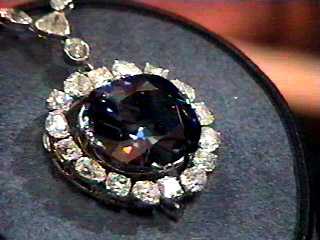
Hope Diamond in it's display case
Hope Diamond in it's display case (another angle)
Hope Diamond and a replica of the stone cut by Scott Sucher from blue cubic zirconium.
The 45.52 carat steel blue Hope Diamond was found in India back in remote times as a rough crystal weighing 112 carats. It first came to light when Jean Baptiste Tavernier, the noted French traveler of the 17th century, was approached in India by a slave who had a very secretive manner about him.
It turned out that he had in his possession an intriguing steel blue stone which at first look seemed to be a large sapphire, but the well-experienced Tavernier soon realized it was a diamond – the largest deep blue diamond in the world.
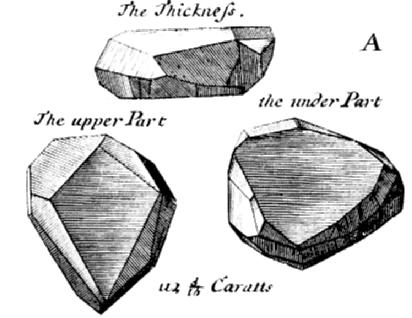
Tavernier's diagram of the Hope's 112-carat rough form.
The legends of the ill-fortune following the possessor of the Hope Diamond are many. From the start Louis XIV, for whom Louisiana was named by La Salle, who claimed the lower Mississippi in his name, (and was killed by his own men) had ill-fortune follow him, perhaps deservedly.
Louis XIV gave the diamond to Madame de Montespan, but she soon went into royal discard. Then came a day when a great festival was given in honor of the King. The Director of Finance, Nicolas Fouquet, had planned well for the occasion, hoping to impress the court. What matter if France was tottering on the brink of revolution, and the nation’s finances none too stable. Was not he, Nicolas Fouquet, reputedly a wealthy man?
So he would borrow the diamond, and the king, he though, would be pleased with such a man of impressively good taste. It didn’t work out that way. After the party, Louis XIV had Nicolas arrested for embezzlement, regained the diamond, and Fouquet was made a “quest” of the Crown at the Fortress of Pignerol where he died 15 years later. Perhaps the idol laughed.
If it did, Louis XIV paid no heed. He continued his harsh rule. It was little wonder that when he was taken to his final resting place, the only lackeys accompanied his funeral carriage down the rutted road to St. Dennis.
Other wearers of the jewel at the Court of France might well have given credence to the legendary curse. Princess de Lamballie, and Marie Antoinette whole followed, both were guillotined during the French Revolution.
The diamond disappeared, and for many years it was not heard from at all, but in 1830, a large steel blue diamond of a different shape, and weighing only 44.50 carats appeared on the market in England was purchased by Henry Thomas Hope, an English banker. In 1851 the diamond was shown at a London exhibition and was insured for a million dollars, an INSANE amount of money for the time period, but then again, this was the largest diamond of it’s type in the world. It was later inherited by a descendant, Lord Francis Pelham Clinton Hope. His wife, formerly a prominent American actress, May Yohe, and a stage star at the beginning of the 20th century, ran away with another man. She died in Boston, Mass., in 1913, practically penniless and forgotten. She had little reguard for the Hope Diamond, and wrote the then owner, Evalyn Walsh McLean, commenting unfavorably on the jewel and the misfortune of it’s owners. Lord Hope eventually went bankrupt and again, the diamond vanished, only to be discovered by the estate trustees after it had been sold as a piece of costume jewelry and lightly reguarded.
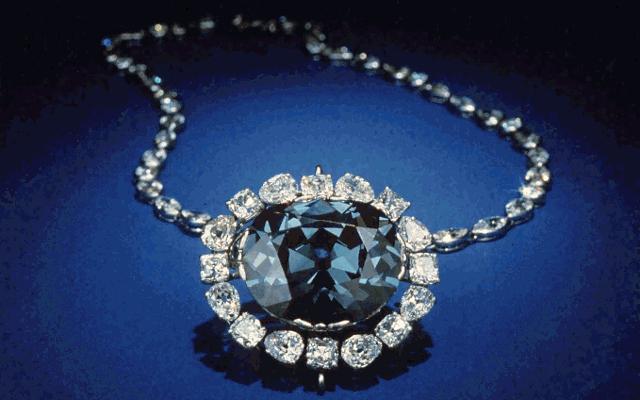
This photo by Dane Penland is the most well-known of the Hope Diamond in the world.
Penland is a photographer for the Smithsonian and has taken photos of many of their gems.

An interesting illustration of the medalion setting the Hope was in before the platinum
and diamond necklace setting (made by Cartier around 1910) in which it now resides.
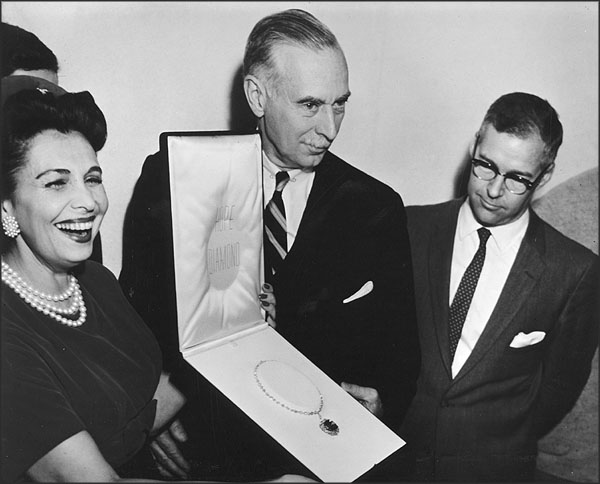
Photo from the formal presentation of the Hope Diamond to the Smithsonian on September 10th, 1958. From left to right:
Mrs. Harry Winston, wife of the donor; Leonard Carmichael, Secretary of the Smithsonian; Dr. George S. Switzer, Curator of Mineralogy.
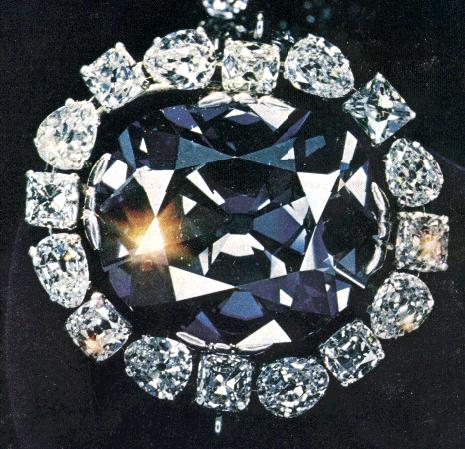
A photo of the Hope from the December, 1971 issue of National Geographic.
It is not known exactly when and where the Hope Diamond was discovered, but it was prior to 1668 and most likely in the Golconda area of India. This region was the only major source of diamonds in the world prior to their discovery in Brazil in 1723. The Kollur mine, in particular, was well known as a source of colored diamonds. In 1668, Jean-Baptiste Tavernier, a French gem merchant, sold a 112 3/16-carat (approximately 110.50 modern metric carats) blue diamond from India to King Louis XIV of France. The diamond was cut in the Indian style, which emphasized size rather than brilliance; probably only the natural crystal faces were polished. The king had the stone recut into a heart shape in 1673, improving its brilliance and reducing it to 67 1/8 carats (69.03 modern metric carats). It is unlikely that any small diamonds could have been fashioned from the cuttings of the original stone.* In 1749 Louis XV had the diamond, now known as the French Blue, set into a piece of ceremonial jewelry for the Order of the Golden Fleece, which also featured a large white diamond and a red spinel, and was only worn by the king. During the reign of King Louis XVI and Queen Marie Antoinette the French Revolution erupted, an sometime between September 11th and September 17th, 1792, the royal treasury was looted and the Crown Jewels, including the French Blue, disappeared.
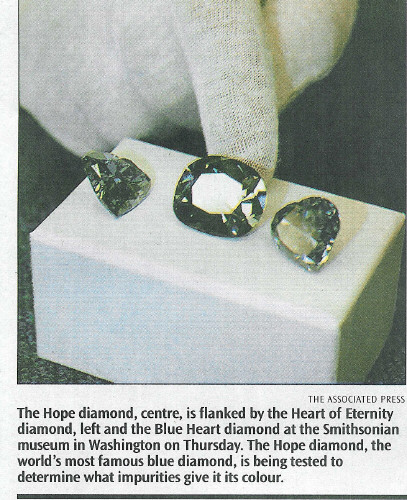
Three of the world's most famous blue diamonds. Left to right: The Heart of Eternity, the Hope,
and the Blue Heart Diamond; 27, 45 and 30 carats, respectively. The Hope looks larger than 45 carats
because it is a rather flat stone. The Heart of Eternity is Fancy Vivid Blue, the Hope is Fancy
Deep Grayish-Blue and the Blue Heart's color grade is Fancy Deep Blue(?).
* Up until recently it has been speculated that the 13.75-carat blue diamond known as the "Brunswick Blue", missing for well over a century now, was a fragment of the French Blue. Other experts have argued the Brunswick Blue II, a 6.50-carat pear-shaped blue diamond is the fragment of the French Blue, rather than the 13.75-carat Brunswick Blue. This was later disproven beyond a shadow of a doubt by gem cutter/diamond replicator Scott Suchor with the help of Smithsonian mineralogy curator Jeffrey E. Post in a Discovery Channel television special "Unsolved History: The Hope Diamond." No secondary gems were fashioned from the French Blue when it was recut into the Hope Diamond.
SOURCES: The National Gem Collection by Jeffrey E. Post, Famous Diamonds by Ian Balfour, Diamonds - Famous, Notable & Unique by Lawrence Copeland. Scott Sucher: www.museumdiamonds.com
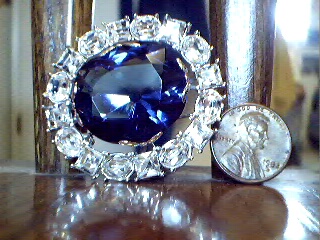
My replica Hope Diamond pin I bought from the Smithsonian through their catalogue around 1992. The piece was about $52 at the time. It now sells for circa $80. I have seen two versions of this pin: One with plastic outer stones, and one with cubic zirconias. The CZ version is better looking, in my opinion.
No comments:
Post a Comment